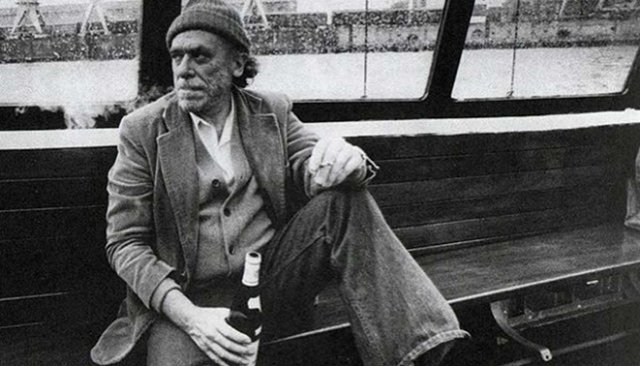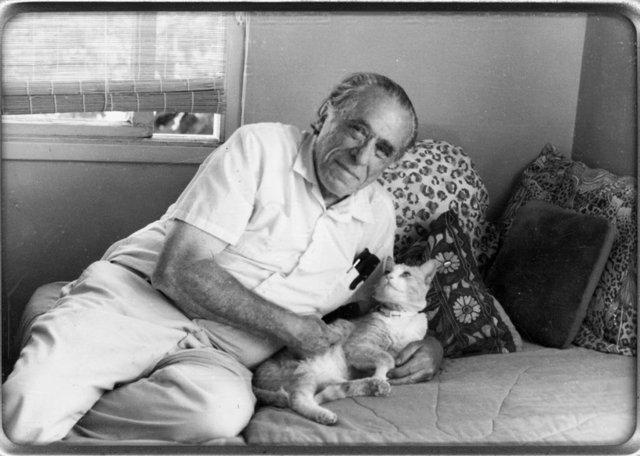/ Charles Bukowski / Aesthetics of Ugliness / essay

About a century ago, Karl Friedrich Rosenkranz in his Aesthetics of Ugliness said that ugliness must have it's place in art.
He shows ugliness to be the negation of beauty without being reducible to evil, materiality, or other negative terms used it's conventional condemnation. When it comes to the aesthetics of the ugly first association would be certainly Charles Baudelaire and the avant-garde poets ... Yet it can be found in the works of many other writers, not so characterized.
Bukowski is an example that the theory of aesthetics of ugliness occurs at the moment of some turmoil. He lived during the Second World War, had German roots, and this political situation probably affected his development. Even the owner of a publishing house, R. R. Cuscaden, wrote an essay in the Satis magazine comparing Bukowski's alienation from the society with Baudaliere's abjectness . (Howard Sounes, 2003, p. 55.) Bukowski was from the beginning a stranger and unacceptable in his surroundings. In his book Ham on Rye, when he talks about childhood, he recalls that all children were cowboys; only his parents bought the Indian costume. In American culture, this is a completely clichéped example of non-deprivation.
![]()
Bukovski wrote short stories, poetry, led diaries, but for his aesthetics of ugliness analysis we will observe his autobiographical novels. Howard Sounes considers that his view of the world has shaped the problems of everyday life, especially the problems of a postal officer who was trying to make a living (Howard Sounes, 2003, p. 81). Life and work at the post office were the subject of his first autobiographical novel . The autobiographical novel in the narrow sense implies that the work is largely based on the writer's personal experience and life, which, in addition to artistic freedom of processing, is much more difficult to reproduce.
Although Bukowski often mentioned that he had biased the biographical data in his novels as well as himself, he claimed that most of what he wrote really did happen. In fact, this is also the essence of his books - honestly presenting himself and his experiences at the bottom of American society. He went even so far that he put the number on it: ninety-three percent of his work was autobiographical, he said, and the other seven were "slightly improved". (Howard Sounes, 2003, p. 16.) Bukowski was the main character of his texts, although he used the imaginative narrator who spoke in the first person.

Post Office is the pioneering work of his career. It's the first and the most debatable, from a series of six novels that outline Henry Kinaski's life and in an innovative yet accessible prose style, which in his simplicity is incredibly similar to his poetry. The novels turned out to be extremely popular with the audience all over the world and in a few years after the publication, The Post Office was translated into fifteen languages.
The rest of the novels from his opus of autobiographical novels are: Ham on Rye, Factotum, Women, Hollywood, and Shakespeare Never Did This. Each of the novels describes a certain period of his life: puberty, middle age, success in old age ... This autobiographical line and humor are what distinguished him from other writers.
What specifically communicates with readers is that his style is understandable to everyone. It was read by all: rock stars, prisoners, whores, poets, homeless ... But he has always claimed that he does not care who reads it: "I have nothing to do with the one who reads me''.
He did not regard writing as an art, but like any other work. He was a l'art pour l'art-ist. And his aesthetics of ugliness does not seem like Baudaliere,with the aim of shocking and motivating to persuade people to wonder, but rather as a shock for shock and ugly for ugly. He does nothing and condemns no one, doesn't point his finger in any kind of sin, but he is the one who is the sinner most often. By reading his books, we get the impression that he enjoyed getting people offended and being despised. He didn't know how to behave when he was loved and appreciated. One of the women who met him told him that he was "massive, furious and dark energy filled with hatred." (Howard Sounes, 2003, p. 125). His aesthetic of ugliness emerged from himself.
Note: this was my translation from Serbian to English from PULSE article ''Estetika ružnog u autobiografskim romanima Čarlsa Bukovskog'' by N.Medic

Alone With Everybody
looking
crawling in and out
of beds.
flesh covers
the bone and the
flesh searches
for more than
flesh.
there's no chance
at all:
we are all trapped
by a singular
fate.
nobody ever finds
the one.
the city dumps fill
the junkyards fill
the madhouses fill
the hospitals fill
the graveyards fill
nothing else
fills.
Great story and as a writer I know how the truth is often harder to accept
Great! Fantastic
The life that lived bukowski was reflected in his writings, and thanks to it today we can enjoy that dark side and dirty realism.
Very nice post!